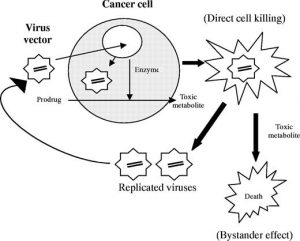Gene therapy is often utilized in targeted diseases with no known therapy or for diseases that their standard treatments have failed. Targeting gene defects in gene therapy consists of addressing a single mutation, multiple mutations in multiple genes, or even demonstrating missing or extra copies in a particular disease.
Additionally, main purpose of gene therapy is introducing a well-defined DNA sequence into specific cells. Virtually, the targeted diseases with gene therapy uses replacing defective genes or imparting a new function. To date, the great majority of gene therapy clinical trials as mentioned in the below have addressed cancer, cardiovascular disease and inherited monogenic diseases; the first two because of their enormous prevalence, impact and potentially fatal outcomes, the latter has a clear appeal and rationale.Further more, it is worth to mention that approximately 6.5% of gene therapy of clinical trials have examined infectious diseases (mainly HIV).
1. Cancer
Recently, most of the clinical trials in gene therapy have been aimed at curing patients with cancer. Different kinds of cancers such as lung, gynaecological, skin, urological, neurological and gastrointestinal tumors, as well as haematological malignancies and paediatric tumors have been targeted by gene therapy.

Cancer as one of targeted diseases for gene therapy photo
2. Cardiovascular diseases
Cardiovascular gene therapy has become the second most popular application for gene therapy.
It is expected that gene therapy will supply a new avenue for therapeutic applications in the growing of blood vessels, protection, regeneration and repair of heart tissue, prevention of the reoccurrence of constricted arteries following a cardiovascular intervention, prevention of the rejection of a bypass, and management of risk-factors.
New blood vessel
A great extent of cardiovascular gene therapy trials to date have focused on therapeutic stimulation of the growing of blood vessels in cases that the blood is restricted.
Two dominant categories of such diseases have been examined in approximately equal numbers, namely myocardial ischemia due to coronary artery disease and lower limb ischemia because of peripheral artery disease. A small number of trials have utilized gene medicines to treat foot ulcers resulting from diabetes.
3. Inherited monogenic diseases
Monogenic diseases are main targets for gene therapy due to their simple single gene
mutations. Moreover, the utilization of gene therapy is more straightforward, because it easily transfers single genes into cells instead of several genes.
The final aim of treating monogenic diseases by gene therapy is the correction of the disorder through the stable transfer of the functioning gene into dividing cells (stem cells) to confirm the permanence of the correction.
The second most common group of inherited diseases targeted has been the severe combined immunodeficiency syndromes, representing about 20% of the trials for monogenic diseases.
Around 20 other monogenic diseases have been treated, but as yet with no obvious therapeutic benefit.
4. HIV
The human immunodeficiency virus (HIV) resulted in acquired immunodeficiency syndrome (AIDS), a serious disease classified by extremely negative effects on the immune system resulting in life-threatening opportunistic infections. Though antiretroviral drugs have diminished the morbidity and mortality of HIV infected patients, currently there is no treatment for this disease. Yet, new developments in gene therapy have focused on introducing genes encoding RNA or proteins which are capable of interfering with intracellular replication of HIV, so called intracellular immunization. So far, the approaches range from protein-based strategies such as fusion inhibitors or zinc finger nucleases to RNA-based approaches such as ribozymes, antisense or short hairpin RNA.
